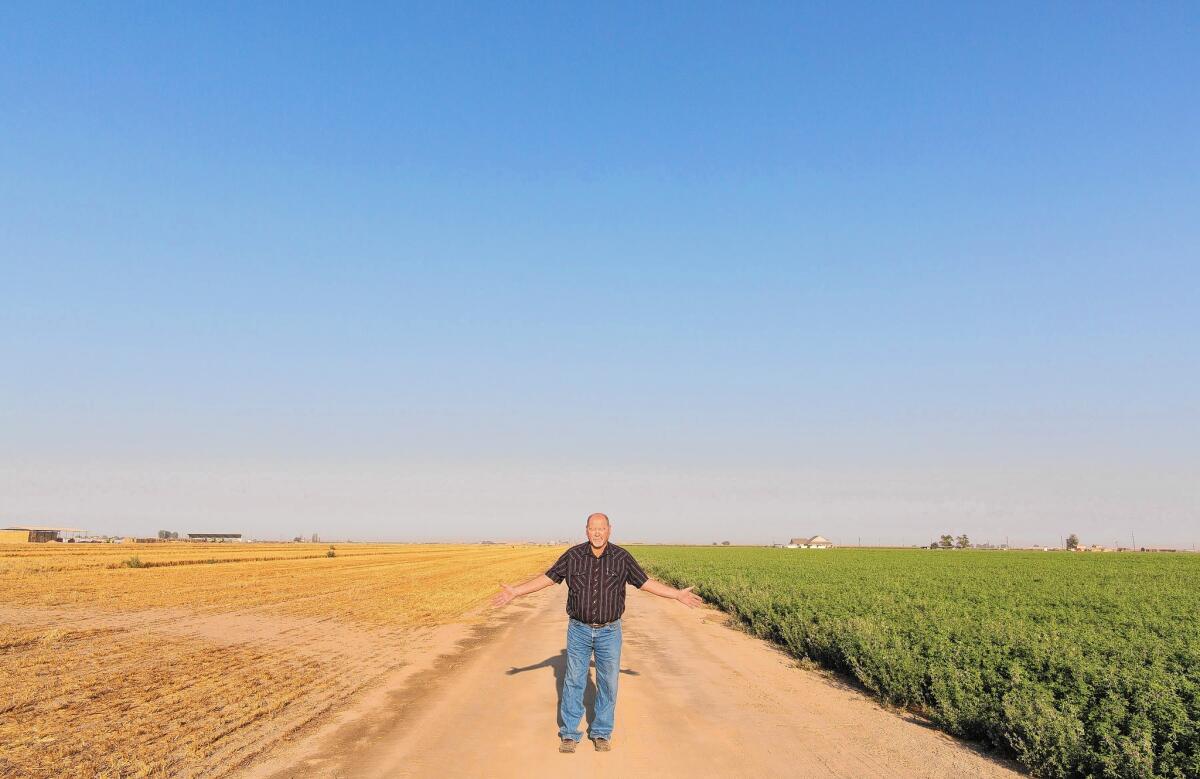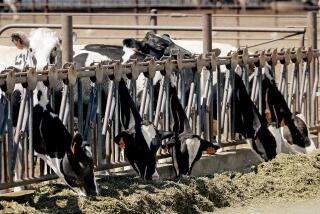California dairy farmers struggling to survive prolonged drought

Dust whips across the toasted soil where Tom Barcellos usually plants corn for his 800 dairy cows. This season, there was no water to plant the crop.
The third-generation dairy farmer was forced to idle a quarter of his 1,200 acres in Tulare County, land that once also bristled with wheat and alfalfa. Now he is buying feed from out of state, paying record-high prices to contractors in Nevada, Texas and as far as Australia for alfalfa hay and corn silage.
Tulare, like most of the state, is struggling through a prolonged and deepening drought. Water is in such short supply that Barcellos paid $150,000 to drill a new well to ensure that his cows have enough to drink.
------------
FOR THE RECORD:
Dairy farmers: In the Oct. 3 Business section, an article about challenges facing California dairy farmers because of the drought said that an acre-foot of water equals 27,160 gallons. In fact, an acre-foot of water, or enough to cover an acre of land with one foot of water, is 325,851 gallons. â
------------
âIf we donât get rain or have a good winter, our farmers might leave the state,â Barcellos said.
California dairy farmers lead the nation in dairy production, churning out 21% of Americaâs milk supply and contributing $140 billion annually to the stateâs economy, according to the U.S. Department of Agriculture.
The historic water crisis has been rough on dairies, driving up the cost of feed and water. Consumers are seeing the effects at the grocery store.
Los Angeles shoppers in August paid an average of $3.79 for a gallon of whole milk, including organic and raw milk, up 54 cents from two years earlier, according to A.C. Nielsen, which tracks retail prices for the state. In San Francisco, the average cost was $4.76 a gallon, up 89 cents.
âAny time you dramatically increase the cost that a farmer faces, it eventually hits consumers,â said Rob Vandenheuvel, general manager at the Milk Producers Council, a nonprofit that represents the stateâs dairy farmers.
Unlike most states, California has its own system for determining what processors pay farmers for conventional milk, a complex formula that many farmers argue does a poor job of incorporating the increasing costs of feed and production. Farmers have been pushing the stateâs Agriculture Department to change the formula, pointing to the many dairy farms that are barely breaking even, have closed or have moved out of state.
California has lost 1% to 2% of its dairy industry in the last three years, said Lesley Butler, a dairy economist at UC Davis. About 100 dairies go out of business every year waiting for rain.
âItâs a huge time of uncertainty,â Butler said.
Most of Californiaâs milk comes from parched counties desperate for drought disaster assistance, according to a recent report from the USDA.
The stateâs dairy farmers have been forced to let about 500,000 acres lie parched and unplanted, making feed for cows and other livestock scarce and expensive. Tulare is one of the hardest hit by the drought; farmers there have failed to plant more than 24,000 acres that once produced feed for cows.
California farmers and ranchers paid 12.4% more for feed in 2013 than 2012, and this yearâs prices have surpassed last yearâs record highs, according to the state Agriculture Department. Farmers recently were paying as much as $350 a ton for premium alfalfa hay, a steep increase from the $200 to $250 a ton they paid last year.
Farmers and feed associations have been fielding calls from growers in Idaho, Wyoming and the Dakotas who are reaching west to supply desperate farmers willing to pay sky-high shipping costs, said Mike Marsh, chief executive of Western United Dairymen.
In addition to higher feed costs, Central Valley farmers are paying on average 10 times more for water for their crops and animals than they were a year ago, said Gayle Holman, a spokeswoman for Fresnoâs Westlands Water District.
In Fresno, farmers who need extra water are paying $800 to $1,100 per acre-foot â about 27,160 gallons, or enough to cover an acre with a foot of water â since the county has no allocated water for agriculture this year, Holman said. Last year, growers could buy an acre-foot of water for $140.
In Tulare, farmers are paying $1,200 to $1,800 per acre-foot, said Tricia Blattler, executive director of the Tulare County Farm Bureau.
âFarmers are suffering from well failure and having to truck in water,â Blattler said âThey are juggling tough decisions based on the cost of water,â such as allocating land to crops that need less water or garner more cash, such as sorghum and almonds.
âThe average dairy here is 1,800 cows,â she said. âSo a large-scale dairy farmer needs 126,000 gallons of water per day just for cows.â
Organic dairies are faring worse than conventional operations. Organic dairy cows can consume only organically produced feed, which is more expensive than non-organic.
Organic cows also have to graze on pasture at least 120 days a year, as required by the USDA. With most California pastures crackled dry, the government lessened the grazing requirement to 90 days, but farmers are still struggling to meet that.
âWeâve lost ⦠grazing pasture because thereâs no rain,â said Albert Strauss, owner of Strauss Family Creamery, an organic dairy and producer in Petaluma. âWe have no irrigation and our reservoirs are dry.â
His dairy cows crawl across his 500 acres in search of roughage, but the acres are all brown. âWeâve already depleted all last yearâs crops,â Strauss said.
He has had to raise his milk prices 5%, or about 50 cents a half gallon, since last year. Unlike conventional farmers such as Barcellos, organic dairy producers set their own prices.
Shaking his head, Strauss said he has watched a handful of neighboring organic farmers go out of business, or switch to conventional production, to weather the drought.
Strauss, whose family-run dairy survived the 1977 drought by hauling in water and drilling a well, works with six other small, Northern California organic dairies. They are all hanging in the balance, he said, frightened by the shortage and cost of feed and the perpetually cloudless skies.
âI am not sure,â he said, âhow we will go another year beyond this.â
More to Read
Inside the business of entertainment
The Wide Shot brings you news, analysis and insights on everything from streaming wars to production â and what it all means for the future.
You may occasionally receive promotional content from the Los Angeles Times.










